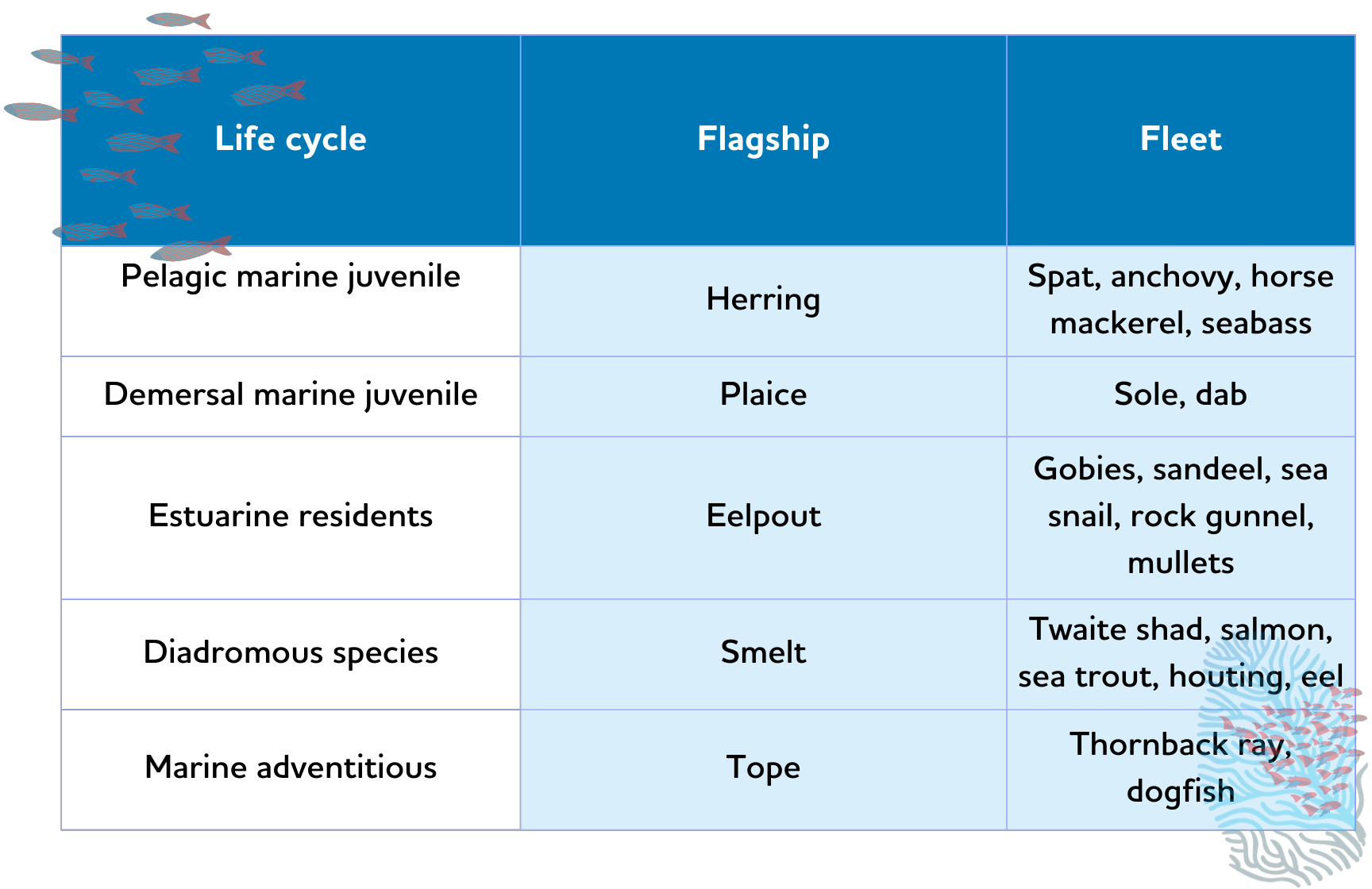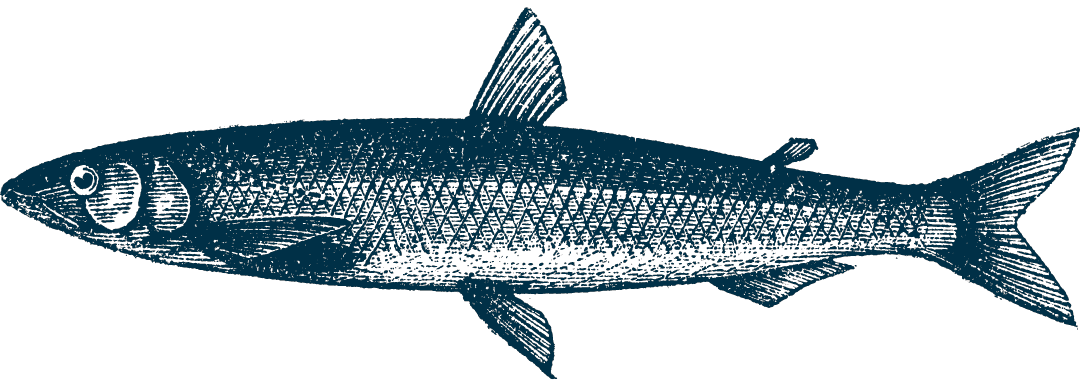Life Cycle Approach
Given the large diversity of fish species potentially observed in the monitoring surveys, a selection of priority species has been made for the SWIMWAY action programme, considering not only functional groups (in terms of life cycle characteristics) but also species with more or less similar lifestyles. Within these groups, knowledge of well-researched, charismatic species (flagship) would be assumed to yield insights also on species with similar lifestyles probably encountering the same conditions and obstacles along their life cycle (fleet).

 Herring play an important role in the Wadden Sea ecosystem. Due to the sheer biomass of juveniles arriving in spring from their spawning grounds along the British east coast and in the English Channel (Corten, 2002; Dickey-Collas, et al., 2009), herring is a critical element in the food web as consumer and prey alike (Dänhardt & Becker, 2011). The arrival of smaller individuals and the emigration or selective mortality of larger specimens within a cohort can result in an almost static length distribution over several weeks in summer (Dänhardt & Becker, 2008). Avian top predators such as terns have adapted their breeding phenology to the seasonal occurrence of the juvenile herring (Dänhardt, 2010).
Herring play an important role in the Wadden Sea ecosystem. Due to the sheer biomass of juveniles arriving in spring from their spawning grounds along the British east coast and in the English Channel (Corten, 2002; Dickey-Collas, et al., 2009), herring is a critical element in the food web as consumer and prey alike (Dänhardt & Becker, 2011). The arrival of smaller individuals and the emigration or selective mortality of larger specimens within a cohort can result in an almost static length distribution over several weeks in summer (Dänhardt & Becker, 2008). Avian top predators such as terns have adapted their breeding phenology to the seasonal occurrence of the juvenile herring (Dänhardt, 2010).
Plaice is one of the most common flatfish species in the Wadden Sea. The spawning grounds are offshore and the planktonic eggs and larvae drift towards the coast. They arrive as postlarvae in the coastal waters and then use selective tidal transport (they move to midwater during the flood tide and settle at the bottom during ebb) to migrate further inshore and into the Wadden Sea (Bolle et al., 2009; van Beek et al., 1989; Zijlstra 1972).
is one of the most common flatfish species in the Wadden Sea. The spawning grounds are offshore and the planktonic eggs and larvae drift towards the coast. They arrive as postlarvae in the coastal waters and then use selective tidal transport (they move to midwater during the flood tide and settle at the bottom during ebb) to migrate further inshore and into the Wadden Sea (Bolle et al., 2009; van Beek et al., 1989; Zijlstra 1972).
 Eelpout
Eelpout
The viviparous blenny or eelpout Zoarces viviparus (Linnaeus 1758) is a boreal species, typical of north European coastal waters, occurring from the English Channel to the White Sea, including the Baltic Sea. The southern Wadden Sea (Dutch and German areas) is the southernmost distribution limit of this species. This non-migrating demersal fish is mainly found in sheltered habitats in estuaries and shallow coastal areas up to 10 meters deep, although a maximum depth of 40 meters has been reported. The eelpout is ovoviviparous, i.e. reproduction occurs through internal fertilization of the eggs which occurs around August. Between December and February, females give birth to about 40–250 fully developed fry of ca. 35 mm long. Adults reach 20 to 40 cm long and have a life span of about 5 to 14 years (Z. viviparus has minor commercial value but is an important prey item for birds, larger fish and sea mammals. (source)
 Smelt is a family member of the salmon and smells of cucumber. A common feature is the ‘adipose’ fin, i.e. a fleshy fin that lacks rays, found on top of the fish near the tail. It is also partly anadromous, meaning it lives in the sea but spawns in estuaries in fresh water and brackish water. The spawning run is in spring and the juveniles migrate out of the estuary in summer to autumn. This anadromous population can reach 30 cm at 8 years. Many bird species, such as terns, rely on smelt for survival (source). In the Netherlands there is also a landlocked population in Lake IJsselmeer; these fish only live 4-5 years and have a maximum length of 15 cm.
Smelt is a family member of the salmon and smells of cucumber. A common feature is the ‘adipose’ fin, i.e. a fleshy fin that lacks rays, found on top of the fish near the tail. It is also partly anadromous, meaning it lives in the sea but spawns in estuaries in fresh water and brackish water. The spawning run is in spring and the juveniles migrate out of the estuary in summer to autumn. This anadromous population can reach 30 cm at 8 years. Many bird species, such as terns, rely on smelt for survival (source). In the Netherlands there is also a landlocked population in Lake IJsselmeer; these fish only live 4-5 years and have a maximum length of 15 cm.
 The Tope shark is a member of the family of the hound sharks (Triakidae) and the order of the Carcharhiniformes. It can be found in colder and temperature waters around the globe, from the shallow waters along the beach to the open water. It is a highly migratory species, carrying out migrations of many hundreds of kilometres for feeding and reproduction (source). This shark feeds on the bottom on pelagic fish, crustaceans, cephalopods, worms and echinoderms. The tope shark is ovoviviparous, the eggs develop within the mother, where they feed on the yolk sac. The larger the mother, the higher the number of pups. The litter can consist of 6 to 52 pups, that are 30 cm long at birth. Gestation lasts 12 months, followed by a two-year resting period after birth (source). The reproductive cycle lasts three years. The species is classified as ‘Critically Endangered’ on the international IUCN Red List (source). The Wadden Sea is likely a nursery area for the tope shark, with the adult females arriving in the summer to pup. The species reaches a maximum of 175-195 cm and is not harmful to humans (source).
The Tope shark is a member of the family of the hound sharks (Triakidae) and the order of the Carcharhiniformes. It can be found in colder and temperature waters around the globe, from the shallow waters along the beach to the open water. It is a highly migratory species, carrying out migrations of many hundreds of kilometres for feeding and reproduction (source). This shark feeds on the bottom on pelagic fish, crustaceans, cephalopods, worms and echinoderms. The tope shark is ovoviviparous, the eggs develop within the mother, where they feed on the yolk sac. The larger the mother, the higher the number of pups. The litter can consist of 6 to 52 pups, that are 30 cm long at birth. Gestation lasts 12 months, followed by a two-year resting period after birth (source). The reproductive cycle lasts three years. The species is classified as ‘Critically Endangered’ on the international IUCN Red List (source). The Wadden Sea is likely a nursery area for the tope shark, with the adult females arriving in the summer to pup. The species reaches a maximum of 175-195 cm and is not harmful to humans (source).




